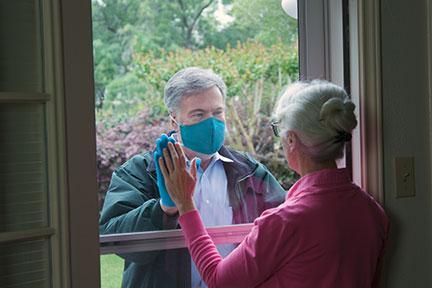
The novel coronavirus disease (COVID-19) has presented new challenges for the elderly. COVID-19 causes significant mortality and morbidity among older adults, particularly those admitted to permanent care institutions.
Individuals are worried about their loved ones who live in different cities or areas. Some of the reasons why seniors are anxious is because they’re living alone, relying on a pension, not being able to drive or take public transportation, and delayed routine health checkups. COVID-19 has amplified the already existing worries of millions of elderly people who have undiagnosed or poorly managed depression.
Here’s how younger individuals can help older generations stay protected from COVID-19:
1. Prevent Outbreak In Elderly Residential Facilities 
The outbreak of COVID-19 has been reported in long-term care facilities throughout the world. Caregivers and other staff members regularly come into contact with the residents of personal care homes, so it’s easy to transmit disease from one person to another. COVID-19 can also be acquired through relatives’ and loved ones’ visits.
COVID-19 has caused a lot of physical, emotional, and social damage in many countries. It is such a good point for the WHO to help nursing home staff and facilities prepare for possible future outbreaks by publishing a communication toolkit and preparedness checklist for them.
2. Follow The Rules
Skilled care facilities are required to implement lockdowns in case of disease outbreak and other dangerous circumstances. They may also put signs against visitors with flu-like symptoms, require staff to monitor their body temperature, and improve current cleaning procedures.
The Centers for Disease Control and Prevention (CDC) also advises long-term care facilities to provide their employees with COVID-19 training. This training can also serve as a refresher to reinforce sanitary practices in facilities too.
Practices such as using disposable nitrile gloves for food prep and disinfecting telephones on a regular basis are easily overlooked. But having both mandated and in-house training can help keep caregivers and other staff members become more thorough in their work.
This way, they can care for patients who’ve been infected and evaluate the immunity and respiratory conditions of all residents. It would be best for senior living communities to learn to live with COVID-19.
3. Reassess Care Plans
There are over a million nursing home residents and almost one million people who live in residential care communities. It’s been suggested that the elderly should not be living in such places since COVID-19 has proven to be challenging to contain there.
However, rehousing a person who needs intensive care is a serious matter that may have severe consequences. Ask yourself if you’re capable of taking care of your loved one at home. After all, they’re in a nursing home because they necessitate additional care you may be unable to provide.
Care plans need to be in place if families decide to cater to their loved one's medical needs at home during a COVID-19 outbreak.
Conclusion
In this pandemic, older people face more challenges these days. The WHO has created a toolkit that can support the necessary procedures in senior facilities and communities so residents can thrive in a safe environment for years to come. Ordinary individuals can also take action in order to lay the foundation for age-friendly societies that support older people's contributions and value them.
 Author: Coline Summers
Author: Coline Summers
Coline Summers is a residential care treatment caregiver. She shares her expertise in caring for patients with COVID-19 through her guest posts and blogs. Coline has years of experience working in different healthcare facilities such as clinics, hospitals, and rural health facilities.
